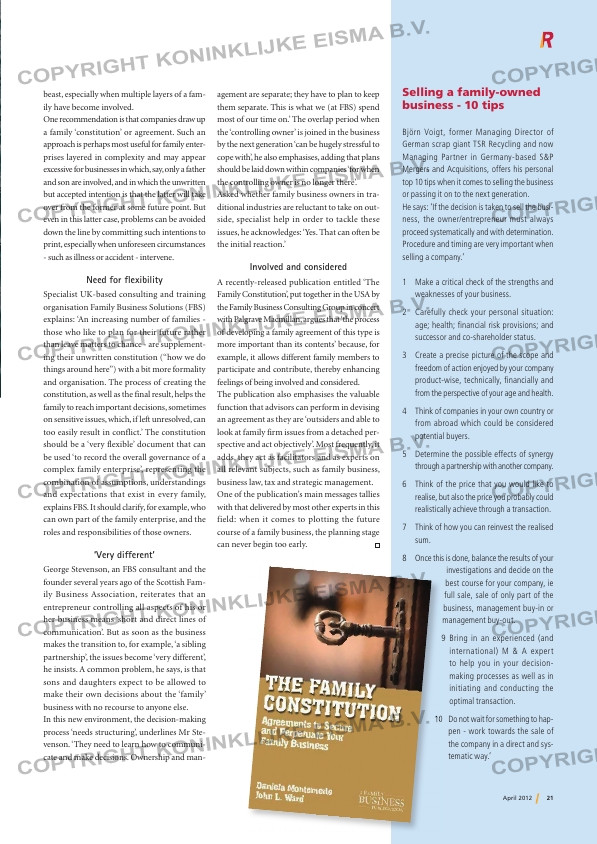Page 21 from: April 2012

21April 2012
beast, especially when multiple layers of a fam-
ily have become involved.
One recommendation is that companies draw up
a family ‘constitution’ or agreement. Such an
approach is perhaps most useful for family enter-
prises layered in complexity and may appear
excessive for businesses in which, say, only a father
and son are involved, and in which the unwritten
but accepted intention is that the latter will take
over from the former at some future point. But
even in this latter case, problems can be avoided
down the line by committing such intentions to
print, especially when unforeseen circumstances
– such as illness or accident – intervene.
Need for flexibility
Specialist UK-based consulting and training
organisation Family Business Solutions (FBS)
explains: ‘An increasing number of families –
those who like to plan for their future rather
than leave matters to chance – are supplement-
ing their unwritten constitution (“how we do
things around here”) with a bit more formality
and organisation. The process of creating the
constitution, as well as the final result, helps the
family to reach important decisions, sometimes
on sensitive issues, which, if left unresolved, can
too easily result in conflict.’ The constitution
should be a ‘very flexible’ document that can
be used ‘to record the overall governance of a
complex family enterprise’, representing the
combination of assumptions, understandings
and expectations that exist in every family,
explains FBS. It should clarify, for example, who
can own part of the family enterprise, and the
roles and responsibilities of those owners.
‘Very different’
George Stevenson, an FBS consultant and the
founder several years ago of the Scottish Fam-
ily Business Association, reiterates that an
entrepreneur controlling all aspects of his or
her business means ‘short and direct lines of
communication’. But as soon as the business
makes the transition to, for example, ‘a sibling
partnership’, the issues become ‘very different’,
he insists. A common problem, he says, is that
sons and daughters expect to be allowed to
make their own decisions about the ‘family’
business with no recourse to anyone else.
In this new environment, the decision-making
process ‘needs structuring’, underlines Mr Ste-
venson. ‘They need to learn how to communi-
cate and make decisions. Ownership and man-
agement are separate; they have to plan to keep
them separate. This is what we (at FBS) spend
most of our time on.’ The overlap period when
the ‘controlling owner’ is joined in the business
by the next generation ‘can be hugely stressful to
cope with’, he also emphasises, adding that plans
should be laid down within companies ‘for when
the controlling owner is no longer there’.
Asked whether family business owners in tra-
ditional industries are reluctant to take on out-
side, specialist help in order to tackle these
issues, he acknowledges: ‘Yes. That can often be
the initial reaction.’
Involved and considered
A recently-released publication entitled ‘The
Family Constitution’, put together in the USA by
the Family Business Consulting Group in concert
with Palgrave Macmillan, argues that ‘the process
of developing a family agreement of this type is
more important than its contents’ because, for
example, it allows different family members to
participate and contribute, thereby enhancing
feelings of being involved and considered.
The publication also emphasises the valuable
function that advisors can perform in devising
an agreement as they are ‘outsiders and able to
look at family firm issues from a detached per-
spective and act objectively’. Most frequently, it
adds, they act as facilitators and as experts on
all relevant subjects, such as family business,
business law, tax and strategic management.
One of the publication’s main messages tallies
with that delivered by most other experts in this
field: when it comes to plotting the future
course of a family business, the planning stage
can never begin too early.
Selling a family-owned
business – 10 tips
Björn Voigt, former Managing Director of
German scrap giant TSR Recycling and now
Managing Partner in Germany-based S&P
Mergers and Acquisitions, offers his personal
top 10 tips when it comes to selling the business
or passing it on to the next generation.
He says: ‘If the decision is taken to sell the busi-
ness, the owner/entrepreneur must always
proceed systematically and with determination.
Procedure and timing are very important when
selling a company.’
1 Make a critical check of the strengths and
weaknesses of your business.
2 Carefully check your personal situation:
age; health; fi nancial risk provisions; and
successor and co-shareholder status.
3 Create a precise picture of the scope and
freedom of action enjoyed by your company
product-wise, technically, fi nancially and
from the perspective of your age and health.
4 Think of companies in your own country or
from abroad which could be considered
potential buyers.
5 Determine the possible effects of synergy
through a partnership with another company.
6 Think of the price that you would like to
realise, but also the price you probably could
realistically achieve through a transaction.
7 Think of how you can reinvest the realised
sum.
8 Once this is done, balance the results of your
investigations and decide on the
best course for your company, ie
full sale, sale of only part of the
business, management buy-in or
management buy-out.
9 Bring in an experienced (and
international) M & A expert
to help you in your decision-
making processes as well as in
initiating and conducting the
optimal transaction.
10 Do not wait for something to hap-
pen – work towards the sale of
the company in a direct and sys-
tematic way.’
A family affair
20 am l s ss-1 21 30-03-12 16:2



